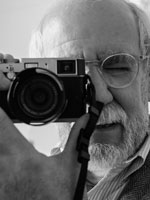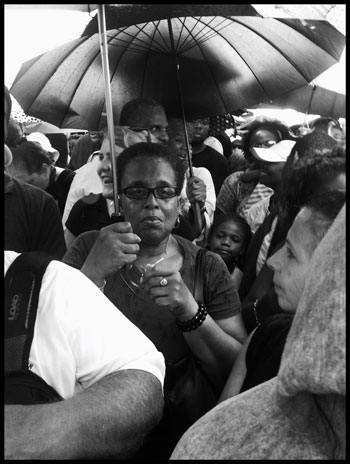
Suppose an editor proposed to a leading photojournalist that she abandon her trusted cameras and lenses and instead cover an important assignment, say a presidential convention or a significant moment in a military campaign, using an off-the-shelf point-and-shoot camera with a Coke-bottle bottom lens, and a sensor smaller than the nail on her pinkie. It’s possible that she might just accept the challenge, figuring that it might be fun to see what she could accomplish with pretty much nothing in the way of equipment, and the resulting photos would undoubtedly receive attention, in a “Holy cow! Will you look at this?!” kind of way. But the photos would be considered artifacts, a sort of photographic self-indulgent silliness and little more.
(This is the first of a series of articles called “SHOOT! About Photography, for Photographers.” SHOOT! is intended more to provoke discussion than to conclude it.)
So what is it with all the big name photographers shooting assignments with camera phones, and with camera output degraded with Instagram? It is hardly news that the best camera we own is the best camera with us when the possibilities of an image materialize. But give up those best cameras in favor of the modern equivalent of a 127 Brownie Box? Why? To prove that we, as professionals, produce worthwhile images using minimal equipment? Again, I would hope we can, and cannot conceive of any reason why we would feel the need to prove that.

Yes, camera phones can be extremely useful tools under certain circumstances, especially when they happen to be the only tool at hand. As it turns out, the iPhone image I created at the 50th anniversary of the March on Washington is by far my favorite image of the day. After upresing it in Genuine Fractals, converting it to black and white using the VSCO Lightroom plugin, and making final adjustments in Photoshop, I just may have a large silver print made of it.
But I do not love it because I shot it with an iPhone; I love it because of the subject, because of the expressions and situation it captures, because of the framing, the composition and the light captured. I love it as a photograph, and the tool I used to capture it is irrelevant. Why did I use my cellphone? I grabbed it because it was raining. I keep it in a water and shock resistant case and I do not trust the combination of rain and my digital Fujifilms – as much as I love working with them and love their glass.
But let me put all this another way. The vast majority of people who have sold one or more of their children to be able to own a Leica have done so because one of their photographic heroes uses — or used — Leicas. They came to believe that only if they owned an M3, an M6, an M7 or now a digital M, with a magic Summicron, they, too, would produce images like those of Cartier-Bresson, Bruce Davidson, Eve Arnold, Elliot Erwitt or Nan Goldin — or any other photographer whose name was ever linked to that of Ernst Leitz.
So if any of those photographers still alive started using camera phones for assignments, would those people who have invested so much in acquiring those Leicas give up the Leicas and switch to camera phones? If they would, they’d prove themselves to be sycophants rather than photographers, and if they wouldn’t, well, case closed.
Camera phones are toys for the masses and emergency backups for serious photographers. To see them as anything else is to fail to understand what photography is really all about, and what role that equipment plays in its creation.


